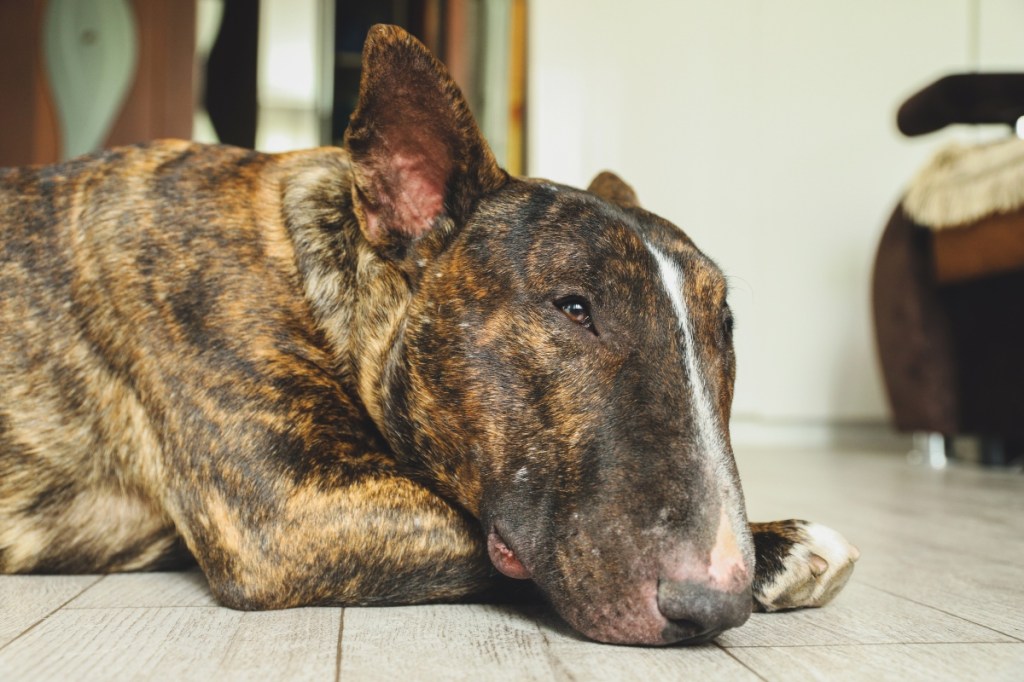Table of Contents
Introduction to Bull Terriers
The bull terrier is a playful and charming breed of dog that is medium in size and mischievous in nature. People love these dogs because of how comical, entertaining, and lovable they are. This is a well-established dog breed that’s a lover, not a fighter. They thrive on consistent human interaction and are likely to become your best friends. Yet bull terriers are full of energy, so they require a good amount of exercise daily to stay healthy and prevent illnesses and injuries.
Could a bull terrier be the perfect dog for you? Read on to learn more about this breed and how pet insurance through Healthy Paws can help you take the best care of your bull terrier’s health.
Size of Bull Terriers
A fully grown bull terrier will stand about 21 to 22 inches tall and weigh between 50 and 70 pounds. These dogs typically stop growing by 12 to 14 months of age.
Below is a chart describing how big you can expect your bull terrier to get as the dog grows from puppyhood to adulthood. The average female weights are on the low end of these ranges, and the average male weights are on the high end.
| Weight Chart | 3 months | 6 months | 9 months | 12 months |
| Female and male bull terriers | 17.6 – 31.5 lbs. | 32.5 – 58.9 lbs. | 40-5 – 75.4 lbs. | 42.8 – 83.2 lbs. |
Characteristics of Bull Terriers
There are certain characteristics of bull terriers that make them unique and special among all dog breeds. For example, this is a dog that’s always busy and wants to be active and energized throughout the day. They can be rambunctious and even destructive if they don’t get the daily exercise they need. But if you put the time and love into your relationship with your bull terrier, you’ll be rewarded with unconditional loyalty and affection. These dogs are not prone to barking, so if you hear one bark, pay attention because something may be wrong.
As you get to know a bull terrier’s personality, here’s what you can expect based on his or her breed characteristics:
| Breed Characteristic | Level (High, Medium, Low) |
| Affectionate with People | High |
| Good with Kids | Medium to High |
| Good with Pets | Medium |
| Need for Exercise | High |
| Energy Level | Medium |
| Intelligence Level | Medium |
| Able to Be Trained | Medium |
| Amount of Barking | Low |
| Amount of Shedding | Medium |

History of Bull Terriers
The history of the bull terrier dates back to when dogs were bred for bull-baiting and fighting. Starting around the 13th century in Britain, bull-baiting was a popular spectator sport that involved cruel competitions between bulldogs and bulls. Even when these sports were outlawed, they continued as underground activities and cost many dogs their lives. Bull terriers were the result of crossbreeding bulldogs and terriers to create a powerful and spirited type of dog. The dogs were crossed with brindle Staffordshire dogs to create different coat colorations.
The American Kennel Club first recognized the bull terrier dog breed in 1885. The Bull Terrier Club of America formed in 1897, and since then, bull terriers have been companion animals for many famous people and have also been featured in books and movies.
Bull Terrier Standard Information
The American Kennel Club provides an official standard of the bull terrier for judging these dogs at shows and competitions. In general, the appearance of the dog is strong, muscular, symmetrical, active, and full of energy. Also, bull terriers have a sweet disposition and listen well to gentle discipline.
Here is an overview of the breed standard information for bull terriers:
Head:
- Long, strong, and deep head
- Oval and full face
- Clean and tight lips
- Level of scissors bite
- Small, thin, and close-together ears
- Black nose with well-developed nostrils
- Dark and well-sunken eyes
Neck, Topline, Body:
- Muscular, long, arched, and tapering neck
- Broad chest with great depth from withers to brisket
- Well-rounded body with back ribs deep and shoulder blades wide and flat
Legs, Feet, Tail:
- Big-boned legs but not coarse
- Forelegs of moderate length
- Hind legs parallel when viewed from behind
- Round and compact feet that are cat-like
- Short tail set on low and carried horizontally
Coat:
- Short, flat coat that is harsh to the tough
- Fine gloss on the coat
- Skin fits tightly
Color:
- White with possible markings on the head
- No markings elsewhere on the coat
Gait:
- Moves compactly and with a sense of agility and power
- Covers the ground with free, easy strides

Caring for Bull Terriers
One of the most important things to know about bull terriers is that they really thrive on human interaction and should live indoors with their families – not left alone outside for long periods of time. These dogs prefer warmer weather and should wear a sweater or coat on cold days in the winter.
Bull terriers are low-maintenance dogs that have minimal grooming needs and moderate exercise needs. They can be a bit challenging to train because of their stubborn nature, making them a good choice for more experienced dog owners. Training should begin early in the dog’s life to prevent aggressive behavior towards dogs and other animals. Bull terriers are excellent playmates for older children who know how to interact with dogs but are perhaps a little too rough and energetic for young children who are frightened by dogs.
Here are some general tips for taking the best care of a bull terrier:
Best Living Environments:
- Homes with fenced-in yards
- Best for pet parents who have prior experience with dogs
Type of Exercise:
- Walks on a leash daily
- Not the best candidates for off-leash dog parks
- 30 to 60 minutes of exercise daily
Mental Enrichment:
- Playtime with family members in a house or yard
- Games with balls and other outdoor activities
Training Strategies:
- Start training and socialization as early as possible
- Training requires extra patience, consistency, and confident leadership
Grooming Tips:
- Short and glossy coat that needs little grooming
- Brush weekly and more frequently during the twice-yearly shedding periods
- Wipe down with a damp cloth for general cleaning
Common Health Problems of Bull Terriers
Bull terriers are generally healthy dogs with an average life span of 12 to 13 years. If you get your bull terrier from a breeder, make sure that you get proof of testing for heart and kidney issues because the breed is prone to these health conditions. The national breed club for bull terriers recommends the following health tests: patella evaluation, kidney test, BAER hearing test, and cardiac exam.
These are some of the most common health issues that arise with bull terriers:
- Hereditary nephritis (kidney disease)
- Heart diseases
- Deafness in one or both ears
- Skin sensitivity or allergies
- Lens luxation (eye condition)
- Ectropion (eyelid abnormality)
- Spinning (tail-chasing that can be a form of seizure)
- Patellar luxation
- Obesity

Diet and Nutrition for Bull Terriers
Bull terriers have a stocky build and can easily become obese. Therefore, it is important not to overfeed your bull terrier or give too many treats for praise and rewards. The recommended daily amount of dry dog food for a bull terrier is 1 5/8 cups to 4 1/4 cups. This is a significant range in the amount of daily food, so discuss appropriate portion sizes for your bull terrier with your vet based on your dog’s weight, age, and level of activity, as well as the caloric density of your dog’s food.
Where to Adopt or Purchase Bull Terriers
The Bull Terrier Club of America provides information about shows, critiques, memberships, breeders, and rescue organizations. There is a breeder directory on the organization’s website where you can search for available puppies in your state.
BTCA Rescue & Welfare is the nonprofit rescue organization of the parent club and offers a hotline to help dogs in need of rescue and also rescue contacts by state. Examples of these contacts include the Blue Ridge Blue Terrier Rescue, Bull Terrier Rescue Mission, and Pet-A-Bulls.
Related Breeds
Do you love the bull terrier breed and the unique personality of these dogs? Then you might also be interested to learn more about similar and related dog breeds before making a final decision on a new pup to bring into your household. Here are some additional breeds to consider:
- American Staffordshire terrier
- Boston terrier
- Staffordshire bull terrier
- Miniature bull terrier
- Bulldog
- Old English terrier
Pet Insurance for Bull Terriers
Because of how active and rambunctious bull terriers can be, it is a smart idea to get pet health insurance for your dog in case of accidental injuries and emergency care that may be needed in the future. Many genetic and heredity conditions don’t start to show symptoms until a bull terrier gets older, so it is wise to have an insurance plan in place before that happens so that treatment coverage is not denied based on a preexisting condition.
At Healthy Paws, we let you take your bull terrier to any licensed veterinarian or emergency in the U.S. when your dog needs care and then make it easy to get reimbursed for the vet bills. We can process most claims within two days after you submit a photo of your bull terrier’s vet bill through our convenient mobile app.
Request your bull terrier health insurance quote today, and be prepared for whatever comes your furry friend’s way.









